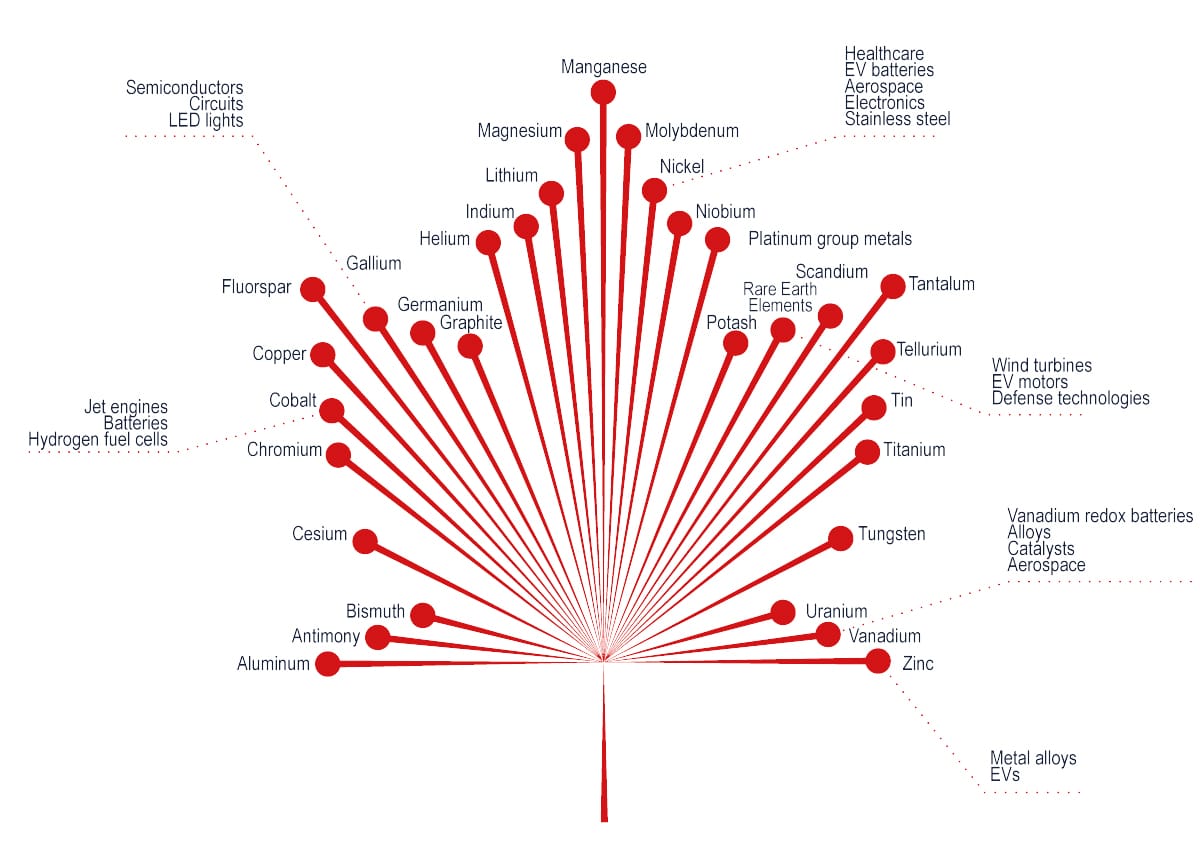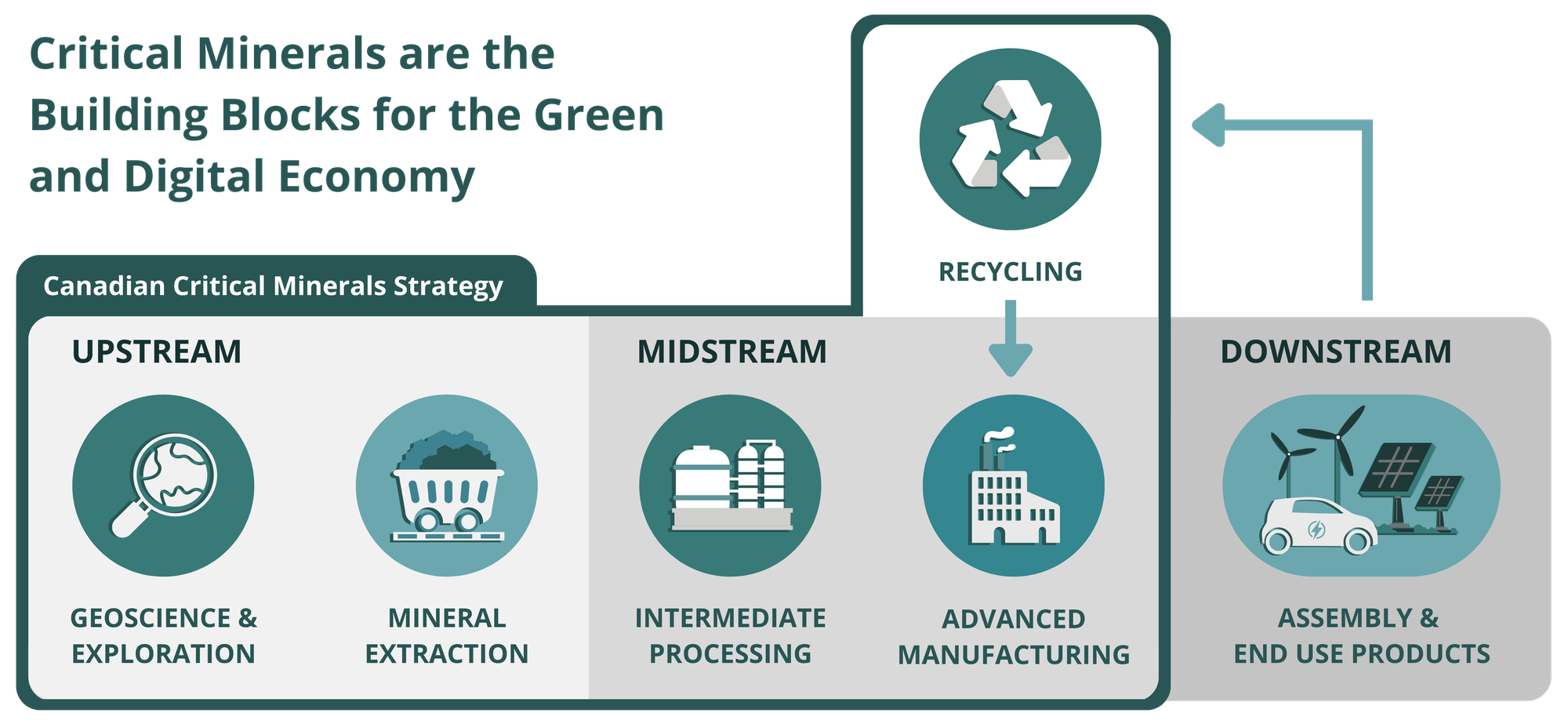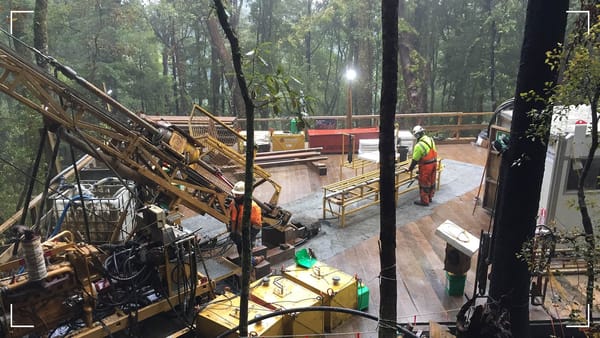The Canadian Critical Minerals Strategy

Vision and Objectives
The Canadian Critical Minerals Strategy outlines an ambitious vision to enhance the supply of responsibly sourced critical minerals, supporting both domestic and global value chains for the green and digital economy. This strategy addresses the global demand for critical minerals, vital for modern technology and the green energy transition, including products like solar panels, wind turbines, and advanced batteries.
"Critical minerals are a generational economic opportunity for Canada. As major enablers of clean technologies and clean energy sources, demand for critical minerals is projected to rise exponentially as the global economy continues to shift toward low-carbon solutions. Through the $1.5-billion Critical Minerals Infrastructure Fund, Canada will make strategic investments in projects to help enable and grow the sustainable development of these minerals, reinforcing Canada's position as a global supplier of choice for clean technology, clean energy and the resources the world needs to build a prosperous net-zero economy."
The Honourable Jonathan Wilkinson
Minister of Energy and Natural Resources
The strategy's objectives are multifaceted, focusing on:
- Economic growth, competitiveness, and job creation.
- Promoting climate action and environmental protection.
- Advancing reconciliation with Indigenous peoples.
- Fostering diverse and inclusive workforces and communities.
- Enhancing global security and partnerships with allies.
Key Areas of Focus
To achieve these objectives, the strategy emphasizes six critical areas:
- Driving research, innovation, and exploration.
- Accelerating project development.
- Building sustainable infrastructure.
- Advancing reconciliation with Indigenous peoples.
- Growing a diverse workforce and prosperous communities.
- Strengthening global leadership and security.
Investment and Funding Initiatives
Critical Minerals Infrastructure Fund (CMIF)
The $1.1 billion CMIF, set to begin accepting applications in late 2023, aims to close the gap between Canada’s critical mineral production and global market resources. This fund is a vital part of the government's broader Critical Minerals Strategy, emphasizing sustainable development of critical minerals like nickel, cobalt, copper, and lithium.
$1.5 Billion Infrastructure Fund
In addition to the CMIF, the Minister of Energy and Natural Resources announced a separate $1.5 billion infrastructure fund. This fund will address key infrastructure gaps and support sustainable critical mineral production, connecting resources to markets and bolstering the entire value chain from exploration to recycling.

Canada's Position in the Global Market
Global Production and Potential
Canada is a leading global producer of many critical minerals, including nickel, potash, aluminum, and uranium. The country's natural wealth positions it to supply even more critical minerals to both domestic and international markets. This potential is further underscored by the rising global demand for these minerals, necessitated by the transition to a green and digital economy.

Integrating ESG Considerations
Commitment to Sustainable Practices
Environmental, Social, and Governance (ESG) standards play a crucial role in Canada's mining and critical minerals sector. Canadian industry is advancing initiatives like the Towards Sustainable Mining program, reflecting a commitment to high ESG standards. This approach aligns with the increasing importance of ESG considerations in global business and investment decisions, particularly in sectors like automotive transitioning towards electric vehicles.

Advancing Circular Solutions
Recognizing the rise in end-of-life clean and digital technologies, the Canadian Critical Minerals Strategy also focuses on circular solutions. This includes developing robust recycling infrastructure and secondary markets, ensuring Canada retains the benefits from its critical mineral extraction for decades to come.

Canada's Role in Shaping the Future of Critical Minerals
As nations worldwide pivot towards a greener, more sustainable future, Canada's comprehensive approach to the critical minerals sector positions it as a pivotal player in shaping this global transition. The country's rich natural resources, combined with strategic investments and a strong commitment to environmental and social governance (ESG) standards, provide a unique opportunity to lead in the supply of these essential materials.
Economic and Geopolitical Impacts
Strengthening Canada's Global Standing
Canada's investments in critical minerals, particularly through the Critical Minerals Infrastructure Fund (CMIF) and the $1.5 billion infrastructure fund, are more than economic initiatives. They represent a strategic move to strengthen Canada's standing in the global market. By focusing on sustainable development and supply chain resilience, these funds aim to position Canada as a reliable, ethical supplier of critical minerals, essential for modern technology and clean energy solutions.
Enhancing Trade and Security Alliances
The strategy also underscores Canada's role in enhancing global security and forming robust trade alliances. By becoming a major supplier of critical minerals, Canada can provide a stable source of these materials to allies, reducing dependence on countries with differing environmental and social governance standards. This shift not only has economic implications but also contributes to a more secure, sustainable global supply chain.
Environmental Leadership and Sustainable Practices
Advancing Green Mining Technologies
In aligning its critical minerals strategy with strong ESG credentials, Canada is set to lead in green mining technologies. The focus on sustainable extraction, processing, and recycling practices reflects a commitment to minimizing the environmental impact of mining activities. This approach is expected to serve as a model for other countries and companies looking to balance economic growth with environmental responsibility.
Promoting Circular Economy Principles
Canada's emphasis on circular solutions in the critical minerals sector is a forward-thinking approach that aligns with global sustainability goals. By increasing access to minerals and metals through recycling and recovering materials from waste streams, Canada is moving towards a more sustainable and efficient use of its natural resources. This initiative is key to retaining the benefits of critical mineral extraction and reducing environmental impacts.
Challenges and Opportunities Ahead
Navigating Supply and Demand Dynamics
While Canada's strategy offers immense potential, it also faces challenges. The global demand for critical minerals is rising rapidly, driven by the transition to a green and digital economy. Canada must navigate these dynamic supply and demand factors, ensuring that its critical minerals sector can meet both domestic and international needs effectively.
Collaborating with Indigenous Communities
An integral part of Canada's strategy is its commitment to advancing reconciliation with Indigenous peoples. Meaningful engagement and partnership with Indigenous communities are crucial for the sustainable development of critical mineral projects. This collaboration is essential to respect Indigenous rights and integrate traditional knowledge in mining practices.
Conclusion: Canada's Path Forward
As Canada continues to implement its Critical Minerals Strategy, it stands at the threshold of a new era in mining and resource management. The strategy's focus on economic growth, environmental sustainability, and global partnerships presents a blueprint for the future of the critical minerals sector. With its vast natural resources, commitment to ESG standards, and innovative approach, Canada is well-positioned to become a global leader in this vital industry, contributing significantly to the world's transition to a net-zero future.




